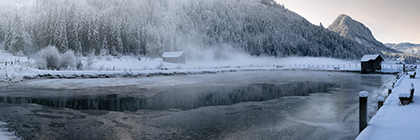Jedes Jahr, nach dem ersten Schneefall, steigen meine Hündin July und ich ins Auto und fahren nach Gosau. In kaum einem anderen Teil des Salzkammergutes gibt es schönere Naturmotive als in dieser, eng ins Tal eingeschlossenen Gemeinde. Und in kaum einem anderen Flecken können die Temperatur so tief fallen wie im Ortsteil Vordertal. Das Thermometer meines Autos zeigte -15° Celsius, ich hab‘ hier aber auch schon -25°C erlebt. July war eingehüllt in einem warmen Mantel, denn selbst Hunde kühlen bei diesen Temperaturen schnell aus - ausgenommen jene Hunderassen die diese Kälte gewöhnt sind, wie z.B. Schlittenhunde. Aber die haben auch ein völlig anderes Verhalten im Winter. Der Schnee knirschte unter meinen Tritten. Ich hatte am Vortag alle Akkus geladen, die Kameras überprüft, die Speicherkarten gelehrt – war also gut vorbereitet. Trotzdem unterlief mir ein gravierender Fehler – ich hatte mich für mein Gitzo Studex Aluminiumstativ entschieden. Dieses Gestell ist schwer und hatte früher sogar meine 6x6 Mittelformatkamera locker getragen. Zu meinen beliebtesten Motiven im Gosau-Vordertal musste ich nicht weit gehen, also nahm ich dieses 6 kg-Trumm mit. Aber – fotografieren mit Handschuhen ist heutzutage kaum mehr möglich. Im analogen Fotozeitalter, als die Kameras noch Räder und Hebeln hatten, war das kein Problem, aber in der digitalen Epoche mit all den Knöpfchen und Touch-Screens ist es fast nicht mehr möglich mit Handschuhen zu arbeiten. Und diese Fingerkuppen freien Handwärmer mag ich auch nicht. Also passierte Folgendes. Meine Hände waren warm,hatte ich doch dicke Handschuhe übergestülpt. Das Stativ hingegen hat sich der Außentemperatur angepasst. Mit meinen warmen Händen fasse ich das Alu-Stativbein an und innerhalb kürzester Zeit klebe ich daran fest. Durch die Berührung meiner warmen Hand mit dem eiskalten Stativ hat sich Kondenswasser gebildet – meine Hand war sofort festgefroren. Minus 15 Grad ist noch keine besonders niedere Temperatur, man kann die Hand wieder relativ leicht lösen. Aber bei -30 Grad oder noch kälter kommst du nicht mehr los - da reißt es dir die Haut vom Fleisch. In einem solchen Fall hilft nur noch eines: ab in die Wärme, die Hand-Stativ-Kombination auftauen lassen und Zähne zusammenbeißen, denn partielle Erfrierungen können wohl zurückbleiben. Schuhe mit dicken Sohlen sind ebenfalls Voraussetzung um längere Zeit im Freien zu verweilen. Ich will hier keine Werbung machen, aber meine Winterschuhe habe ich von Josef Seibel. Wer diese Marke kennt weiß, dass dies keine schlechte Ware ist. Die Sohlen sind mehrere Zentimeter stark, das Innenfutter aus isolierendem wärmendem Material. Trotzdem, nach eineinhalb Stunden schlug die Kälte durch. Schon meine Großvater hat gesagt: „Wånn da en de Zechan koalt is, friat boald da gånze Körpa“. Recht hatte er, Gott hab in selig! Aber das Wetter und das Licht waren stabil und nach zwei Stunden hatte ich meine Aufnahmen im Kasten. July war auch sichtlich froh wieder ins warme Auto zu kommen.
Every year, after the first snowfall, my dog July and I get in the car and drive to Gosau. In hardly any other part of the Salzkammergut are there more beautiful natural motifs than in this municipality, which is tightly enclosed in the valley. And in hardly any other place can the temperature fall as low as in the district of Vordertal. The thermometer in my car showed -15° Celsius, but I've also experienced -25°C here. July was wrapped in a warm coat, because even dogs cool down quickly in these temperatures - except for those dog breeds that are used to this cold, such as sled dogs. But they also have a completely different behavior in winter. The snow crunched under my feet. I had charged all the batteries the day before, checked the cameras, taught the memory cards - so I was well prepared. Nevertheless, I made a serious mistake - I chose my Gitzo Studex aluminum tripod. This frame is heavy and used to easily support even my 6x6 medium format camera. I didn't have to go far to my most popular motifs in Gosau-Vordertal, so I took this 6 kg drum with me. But – taking photos with gloves is hardly possible nowadays. In the analog photo age, when cameras still had wheels and levers, that wasn't a problem, but in the digital age with all the buttons and touch screens, it's almost impossible to work with gloves. And I don't like those hand warmers without fingertips either. So this is what happened. My hands were warm because I had thick gloves on. The tripod, on the other hand, has adapted to the outside temperature. I grab the aluminum tripod leg with my warm hands and I'm stuck to it in no time. Condensation formed when my warm hand touched the ice-cold tripod – my hand was immediately frozen. Minus 15 degrees is not a particularly low temperature, you can release your hand again relatively easily. But at -30 degrees or even colder you can't get rid of it - it tears your skin from your flesh. In such a case, there is only one thing left to do: get out in the warmth, let the hand-tripod combination thaw and bite your teeth, because partial frostbite can probably remain. Shoes with thick soles are also a prerequisite for staying outdoors for a long time. I don't want to advertise here, but I got my winter shoes from Josef Seibel. Anyone who knows this brand knows that this is not a bad product. The soles are several centimeters thick, the inner lining is made of insulating, warming material. Nevertheless, after an hour and a half the cold hit. Even my grandfather said: "When there is a Zechan Koalt, friat boald da gånze Körpa". He was right, God bless him! But the weather and the light were stable and after two hours I had my shots in the can. July was also obviously happy to get back into the warm car.
Väterchen Frost im Gosau Vordertal
jack frost in the village of gosau vordertal

